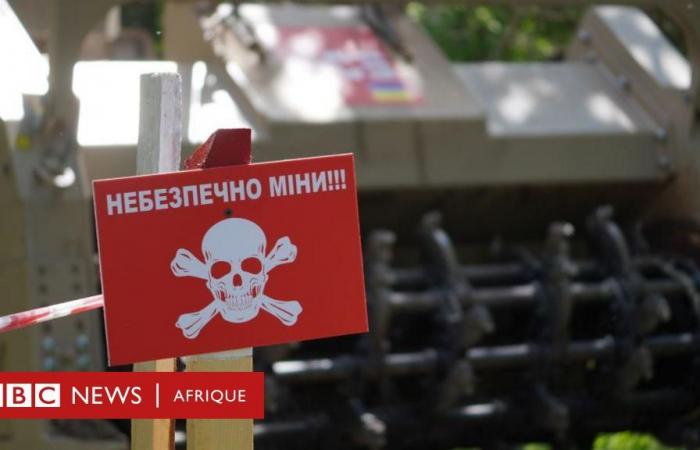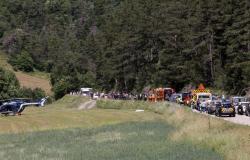Photo credit, Getty Images
- Author, George Erman
- Role, BBC News Ukraine
-
11 minutes ago
“At first I didn’t even feel any pain,” Lidia says, recalling the day that left a lasting impression on her. “There was an explosion, and then I saw a fountain of blood coming out of my foot.”
In July 2023, this septuagenarian went to a forest to pick mushrooms in her hometown of Izyum, in northeastern Ukraine. In the forest, she stepped on a PFM-1S antipersonnel mine, also called a “butterfly mine” or “petal mine” because of its shape and color.
Much of Ukrainian territory to the east and south, which was occupied by Moscow in 2022, remains contaminated by explosives planted by retreating Russian forces.
The mine that blew off Lidia’s foot is one of the most numerous. Measuring approximately 12 cm in diameter, it comes in several colors, including green and brown, to conceal the explosive on the ground and in vegetation.
The explosion also injured Lidia’s other foot and one of her arms. She managed to bandage her badly injured foot, but did not want to return to town, fearing she would lose consciousness.
“My phone was only a few meters away and I had to crawl to reach it. Everything was covered in blood, sand and pine needles,” Lidia recalls. She managed to phone a friend who sent her help.
Having lost a lot of blood, Lidia spent almost two months in hospital and now has a prosthetic foot.
“No one thought I would survive, but I did. Today, all I think about is mushrooms. I desperately want to go pick some, but I can’t,” she says. However, she remains hopeful.
“Life goes on. I can walk a little; I take care of my vegetable patch and my garden – the strawberries ripen well. But I can’t go to the forest. I don’t worry about myself. My heart only suffers for Ukraine,” laments Lidia.
A quarter of Ukraine
Since the start of the full-scale war in February 2022, there have been at least 667 incidents in Ukraine caused by mines and other explosives scattered across the country, according to the Mine Action Center, which is under the umbrella of of the Ministry of Defense.
During these explosions, 297 civilians were killed and 677 injured.
Authorities estimate that almost a quarter of Ukraine’s territory may currently be contaminated by mines and unexploded ordnance.
Last year, an area of 3,300 km² was cleared, and this year the figure remained at just 1,080 km², according to government data.
“Mostly I encountered anti-tank mines,” says Senior Sergeant Kostyantyn Shatylo, who heads the mine clearance battalion of a specialized unit of the Defense Ministry.
“The most common are the TM-62M, TM-62P3 and PMN2 series anti-personnel mines, but sometimes we come across the OZM72 pop-up anti-personnel mine, which is one of the most dangerous,” he adds.
Official estimates for the time needed to completely demine Ukraine range from a decade to thirty years.
Ukraine therefore risks appearing on the list of countries which are struggling to demine their territory even though they are no longer conflict zones.
For example, in Cambodia, a country which experienced a civil war between 1967 and 1975 and an armed conflict with Vietnam from 1977 to 1991, the authorities estimate that there remain four to six million mines on the ground.
Photo credit, Getty Images
From 1979 to 2023, mines killed nearly 20,000 people and more than 45,000 were injured in explosions, according to the Cambodian Mine Action and Victim Assistance Authority (CMAA), a government agency. .
According to CMAA, more than a million people in the country continue to live in areas at high risk of mine contamination.
Bosnia is another example. Although the Bosnian War ended in 1995, mine clearance efforts have been ongoing for nearly thirty years. An estimated 2% of the country’s territory still needs to be cleared.
In Colombia, more than 12,000 people have been killed in mine explosions over the past three decades. Last year alone, 85 people were killed by mines, according to the United Nations.
But the threat posed by mines in Ukraine is more complex, says Denys Holovetskyi of the HALO Trust, a nongovernmental humanitarian organization that focuses on clearing landmines and other explosive devices left over from conflict.
He emphasizes that the war in Ukraine is not over, the mines scattered in the fields are new and work perfectly well.
“Our organization has been working in Afghanistan for a long time. And there, some mines don’t work, the stretchers are rotten,” he explains. “But in Ukraine, everything works.”
In Ukraine, the mine clearance action is coordinated by the Ministry of Defense and technical assistance is provided by kyiv’s partners in the United States, United Kingdom, Canada, Lithuania, the Netherlands and Sweden.
“The main difficulty lies in the lack of modern equipment: mechanized mine-clearing machines, specialized transportation of explosive objects and personal protective equipment,” explains Major General Serhii Zatolokin, head of the State Special Transport Service, one government agencies responsible for mine clearance. The lack of qualified personnel is also a problem.
Photo credit, Getty Images
One of the foreign centers where Ukrainian deminers are trained is in Kosovo. Even though advanced technologies such as drones are used for demining, the need for well-trained personnel persists, according to Ben Remfrey, who trains Ukrainians at the center.
“You can have drones. You can have thermal cameras. You can have remote controls to go and cut plants, you can eliminate a lot of munitions. But only a well-trained person with a good set of tools will ultimately be able to secure each object…” he explains.
Faced with the unprecedented threat posed by mines in Ukraine, it is civilians – mainly farmers and other rural dwellers, children and the elderly – who suffer the most.
Fatal incidents occur when people attempt to clear the land themselves, without any prior training.
That’s why sappers Artem Yushchenko and Oleksandr Borysenko go to schools to teach children how to avoid mines.
“We show them what explosive devices look like, we explain to them how to behave around them. We tell them: if you find a mine, don’t go near it, don’t touch it, call the emergency services and let brands [pour signaler la présence d’une mine]”, explains Oleksandr.
The two sappers were injured during mine clearance operations in the Kharkiv region in eastern Ukraine, a few months after the expulsion of the Russian army.
Oleksandr lost his foot and had to undergo prosthetic surgery in the United States.
“During mine safety classes, if older children are present, I show my prosthesis so that they understand the consequences of not respecting the rules,” he explains.
Artem Yushchenko says it is often difficult to convince people of the serious danger posed by mines.
“The other day an old lady was walking down the street and picked up our marking sticks, because she needed stakes for her tomato plants,” he complains.
“We tell people not to pick them up, don’t even touch them, because if the marks disappear, others will think the area is cleared. But that’s not the case. The mines can explode.”






